| Listing 1 - 7 of 7 |
Sort by
|
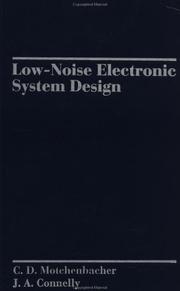
ISBN: 0471577421 9780471577423 Year: 1993 Publisher: New York Wiley J. & Sons
Abstract | Keywords | Export | Availability | Bookmark
 Loading...
Loading...Choose an application
- Reference Manager
- EndNote
- RefWorks (Direct export to RefWorks)
Electronic circuit design --- Electronic circuits --- Circuits électroniques --- Data processing --- Noise --- Calcul --- Informatique --- Bruit --- 621.38 --- 621.391.82 --- Elektronica --- Ruisarm ontwerpen --- Circuits électroniques --- Noisy circuits --- Design --- Electronic circuits - Noise --- Electronic circuit design - Data processing
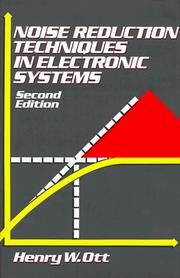
ISBN: 0471850683 9780471850687 Year: 1988 Publisher: New York, NY : John Wiley,
Abstract | Keywords | Export | Availability | Bookmark
 Loading...
Loading...Choose an application
- Reference Manager
- EndNote
- RefWorks (Direct export to RefWorks)
Cabling. Grounding. Balancing and Filtering. Passive Components. Shielding. Contact Protection. Intrinsic Noise Sources. Active Device Noise. Digital Circuit Noise and Layout. Digital Circuit Radiation. Electrostatic Discharge. Appendices. Symbols.
elektrische circuits --- storingen --- Electronics --- ruis --- Electronic circuits --- Circuits électroniques --- Noise --- Bruit --- Noise. --- -HF --- technieken --- geluid --- elektrische systemen --- 621.391.822 --- elektrische meettechniek --- elektronica --- lawaaibestrijding --- Electron-tube circuits --- Electric circuits --- Electron tubes --- Interference due to noise --- 621.391.822 Interference due to noise --- HF --- Noisy circuits --- Electronic circuits - Noise. --- Elektronische ruis. --- Noise (electronic circuits)
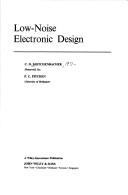
ISBN: 0471619507 9780471619505 Year: 1973 Publisher: New York (N.Y.) Wiley
Abstract | Keywords | Export | Availability | Bookmark
 Loading...
Loading...Choose an application
- Reference Manager
- EndNote
- RefWorks (Direct export to RefWorks)
Electronic circuit design --- Electronic noise --- Circuits électroniques --- Bruit électronique --- Data processing --- Calcul --- Informatique --- Electronic circuits --- Noise --- -Electronic circuits --- -621.391.82 --- Electron-tube circuits --- Electric circuits --- Electron tubes --- Electronics --- Interference. Static --- Design --- Electronic circuit design. --- Data processing. --- Noise. --- 621.391.82 Interference. Static --- Circuits électroniques --- Bruit électronique --- 621.391.82 --- Noisy circuits --- Electronic circuits - Noise --- Electronic circuit design - Data processing
Book
ISBN: 8847019850 8847019869 1283849712 Year: 2011 Publisher: Milan : Springer,
Abstract | Keywords | Export | Availability | Bookmark
 Loading...
Loading...Choose an application
- Reference Manager
- EndNote
- RefWorks (Direct export to RefWorks)
L’opera fornisce una trattazione chiara, agile ed essenziale, ma completa, del rumore elettrico, argomento considerato generalmente oscuro e specialistico. Molto più breve (circa 275mila battute) dei testi attualmente disponibili. Il contenuto copre gli aspetti essenziali della matematica e della fisica del rumore (termico, shot. 1/f, …), e della sua rappresentazione nei circuiti. Discute quindi il rumore nei dispositivi passivi e attivi, e introduce i criteri di progettazione a basso rumore. Affronta infine brevemente questioni quali l’estrazione del segnale dal rumore e gli impieghi utili del rumore. L’attenzione è generalmente rivolta alla strumentazione fisica a bassa frequenza, in relazione alla pluridecennale esperienza specifica dell’autore. Si tratta di una estensione delle dispense, utilizzate per anni, di un corso universitario. Pertanto la trattazione è fortemente didattica, con particolare attenzione a rimuovere ambiguità e incertezze, discutendo il materiale in termini fisici intuitivi, presentando esempi esplicativi e proponendo esercizi.
Electronic circuits - Noise. --- Electronic circuits. --- Electronic noise. --- Physics --- Physical Sciences & Mathematics --- Physics - General --- Electro-acoustics. --- Electroacoustics --- Physics. --- Acoustics. --- Physics, general. --- Electronic Circuits and Devices. --- Acoustical engineering --- Electrical engineering --- Music --- Sound --- Acoustics and physics --- Natural philosophy --- Philosophy, Natural --- Physical sciences --- Dynamics --- Electron-tube circuits --- Electric circuits --- Electron tubes --- Electronics
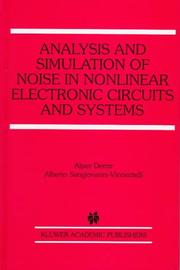
ISBN: 0792380371 9780792380375 1461377773 1461560632 Year: 1998 Volume: SECS 425 Publisher: Boston Kluwer
Abstract | Keywords | Export | Availability | Bookmark
 Loading...
Loading...Choose an application
- Reference Manager
- EndNote
- RefWorks (Direct export to RefWorks)
In electronic circuit and system design, the word noise is used to refer to any undesired excitation on the system. In other contexts, noise is also used to refer to signals or excitations which exhibit chaotic or random behavior. The source of noise can be either internal or external to the system. For instance, the thermal and shot noise generated within integrated circuit devices are in ternal noise sources, and the noise picked up from the environment through electromagnetic interference is an external one. Electromagnetic interference can also occur between different components of the same system. In integrated circuits (Ies), signals in one part of the system can propagate to the other parts of the same system through electromagnetic coupling, power supply lines and the Ie substrate. For instance, in a mixed-signal Ie, the switching activity in the digital parts of the circuit can adversely affect the performance of the analog section of the circuit by traveling through the power supply lines and the substrate. Prediction of the effect of these noise sources on the performance of an electronic system is called noise analysis or noise simulation. A methodology for the noise analysis or simulation of an electronic system usually has the following four components: 2 NOISE IN NONLINEAR ELECTRONIC CIRCUITS • Mathematical representations or models for the noise sources. • Mathematical model or representation for the system that is under the in fluence of the noise sources.
Electronic circuits --- Electric circuits, Nonlinear --- Electric circuit analysis. --- Circuits électriques --- Noise --- Computer simulation. --- Data processing. --- Analyse --- Electric circuit analysis --- Computer simulation --- Data processing --- Circuits électriques --- Electron-tube circuits --- Electric circuits --- Electron tubes --- Electronics --- Nonlinear electric circuits --- Circuit analysis, Electric --- Electric network analysis --- Noise&delete& --- Electrical engineering --- Electronic circuits. --- Electrical engineering. --- Computer-aided engineering. --- Circuits and Systems. --- Electrical Engineering. --- Computer-Aided Engineering (CAD, CAE) and Design. --- CAE --- Engineering --- Electric engineering --- Electronic circuits - Noise - Computer simulation --- Electric circuits, Nonlinear - Data processing
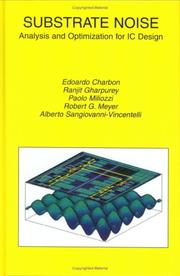
ISBN: 9780792373254 0792373251 9780306481710 0306481715 Year: 2003 Publisher: New York, New York : Kluwer Academic Publishers,
Abstract | Keywords | Export | Availability | Bookmark
 Loading...
Loading...Choose an application
- Reference Manager
- EndNote
- RefWorks (Direct export to RefWorks)
In the past decade, substrate noise has had a constant and significant impact on the design of analog and mixed-signal integrated circuits. Only recently, with advances in chip miniaturization and innovative circuit design, has substrate noise begun to plague fully digital circuits as well. To combat the effects of substrate noise, heavily over-designed structures are generally adopted, thus seriously limiting the advantages of innovative technologies. Substrate Noise: Analysis and Optimization for IC Design addresses the main problems posed by substrate noise from both an IC and a CAD designer perspective. The effects of substrate noise on performance in digital, analog, and mixed-signal circuits are presented, along with the mechanisms underlying noise generation, injection, and transport. Popular solutions to the substrate noise problem and the trade-offs often debated by designers are extensively discussed. Non-traditional approaches as well as semi-automated techniques to combat substrate noise are also addressed. Substrate Noise: Analysis and Optimization for IC Design will be of interest to researchers and professionals interested in signal integrity, as well as to mixed signal and RF designers.
Integrated circuits --- Electronic circuits --- Circuits intégrés --- Circuits électroniques --- Design and construction. --- Noise. --- Conception et construction --- Bruit --- -Integrated circuits --- Electron-tube circuits --- Electric circuits --- Electron tubes --- Electronics --- Noise --- Computer aided design. --- Computer engineering. --- Electronic circuits - Noise. --- Engineering. --- Integrated circuits. --- Systems engineering. --- Electrical & Computer Engineering --- Engineering & Applied Sciences --- Electrical Engineering --- Design and construction --- Computer-aided engineering. --- Electrical engineering. --- Electronic circuits. --- Circuits and Systems. --- Electrical Engineering. --- Computer-Aided Engineering (CAD, CAE) and Design. --- Noisy circuits --- CAE --- Engineering --- Electric engineering --- Data processing
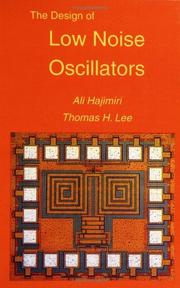
ISBN: 0792384555 0306481995 9780792384557 Year: 2003 Publisher: New York : Kluwer Academic Publishers,
Abstract | Keywords | Export | Availability | Bookmark
 Loading...
Loading...Choose an application
- Reference Manager
- EndNote
- RefWorks (Direct export to RefWorks)
It is hardly a revelation to note that wireless and mobile communications have grown tremendously during the last few years. This growth has placed stringent requi- ments on channel spacing and, by implication, on the phase noise of oscillators. C- pounding the challenge has been a recent drive toward implementations of transceivers in CMOS, whose inferior 1/f noise performance has usually been thought to disqualify it from use in all but the lowest-performance oscillators. Low noise oscillators are also highly desired in the digital world, of course. The c- tinued drive toward higher clock frequencies translates into a demand for ev- decreasing jitter. Clearly, there is a need for a deep understanding of the fundamental mechanisms g- erning the process by which device, substrate, and supply noise turn into jitter and phase noise. Existing models generally offer only qualitative insights, however, and it has not always been clear why they are not quantitatively correct.
Oscillators, Electric --- Electronic circuits --- Electronic noise --- Radio frequency oscillators --- Oscillateurs --- Circuits électroniques --- Bruit électronique --- Oscillateurs haute fréquence --- Design and construction --- Noise --- Conception et construction --- Bruit --- -Electronic noise --- -Radio frequency oscillators --- RF oscillators --- Electric oscillators --- Electric apparatus and appliances --- Electric machinery --- Radio --- Noise, Electronic --- Signal theory (Telecommunication) --- Electric noise --- Electron-tube circuits --- Electric circuits --- Electron tubes --- Electronics --- Computer engineering. --- Design and construction. --- Electronic circuits. --- Electronic noise. --- Engineering. --- Noise. --- Oscillators, Electric. --- Oscillators. --- Electrical & Computer Engineering --- Engineering & Applied Sciences --- Electrical Engineering --- Radio frequency oscillators. --- Circuits électroniques --- Bruit électronique --- Oscillateurs haute fréquence --- EPUB-LIV-FT SPRINGER-B --- Electrical engineering. --- Circuits and Systems. --- Electrical Engineering. --- Systems engineering. --- Noisy circuits --- Electric engineering --- Engineering --- Oscillators, Electric - Design and construction --- Electronic circuits - Noise
| Listing 1 - 7 of 7 |
Sort by
|

 Search
Search Feedback
Feedback About UniCat
About UniCat  Help
Help News
News